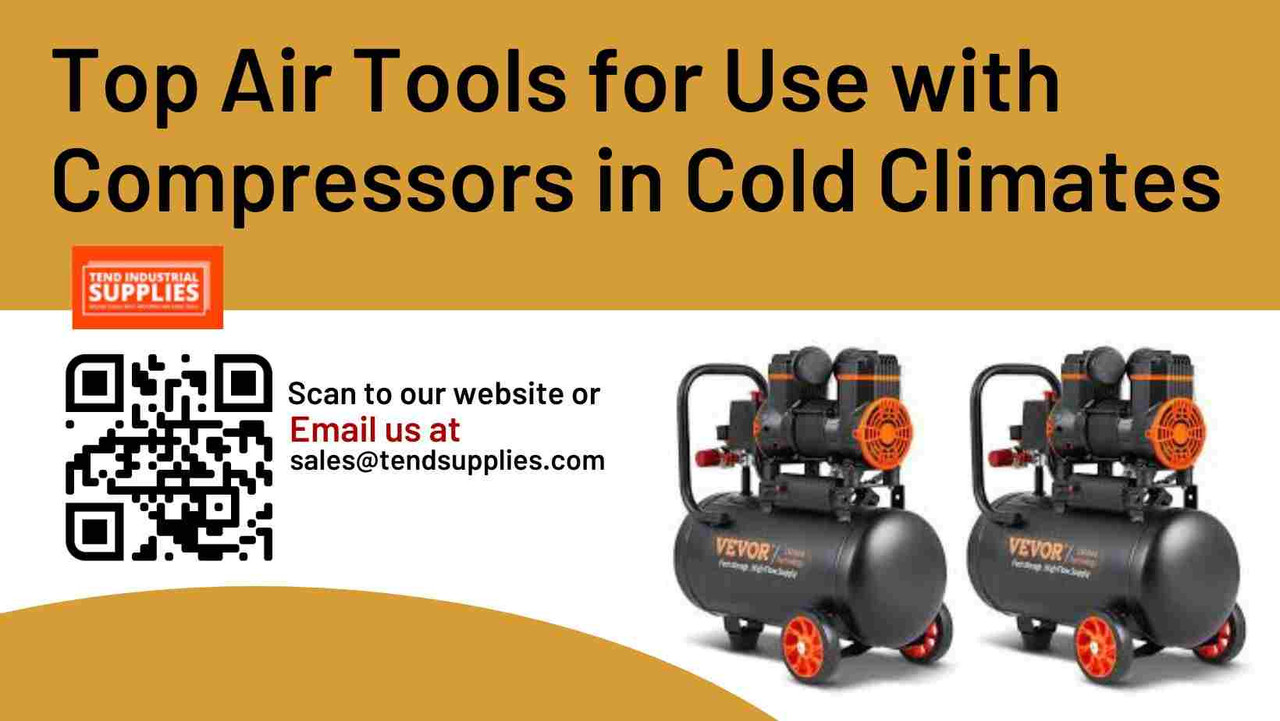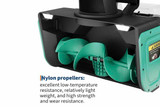Top Air Tools for Use with Compressors in Cold Climates
Working in cold climates presents unique challenges for both air compressors and the pneumatic tools they power. As temperatures drop, it becomes crucial to select tools that can withstand and perform efficiently in harsh conditions. This comprehensive guide will explore the top air tools designed for use with compressors in cold climates, helping professionals and DIY enthusiasts alike make informed choices for their winter projects.
Key Takeaways
- Cold-resistant materials and specialized designs are crucial for air tools used in low temperatures.
- Proper lubrication and moisture management are essential for optimal tool performance in cold climates.
- Some air tools are better suited for cold weather use than others due to their design and functionality.
- Regular maintenance and proper storage are vital for extending the lifespan of air tools used in cold environments.
- Investing in high-quality, cold-weather-specific air tools can significantly improve productivity and reliability in winter conditions.
Understanding Cold Weather Challenges for Air Tools
Before diving into specific tool recommendations, it's important to understand the challenges that cold weather poses for pneumatic tools:
- Increased Air Density: Cold air is denser, potentially affecting tool performance.
- Moisture Issues: Cold temperatures can lead to condensation and freezing in air lines and tools.
- Material Contraction: Some materials may contract in cold, affecting tool tolerances and performance.
- Lubrication Problems: Cold can cause lubricants to thicken, reducing their effectiveness.
- Reduced Flexibility: Hoses and seals may become less flexible in cold temperatures.
Top Air Tools for Cold Climate Use
1. Impact Wrenches
Impact wrenches are essential for many cold weather applications, particularly in automotive and construction work.
Top Pick:Shinano SI-1490B 1/2" Drive Air Impact Wrench
Key Features:
- Robust Construction: Built with a durable housing to withstand extreme temperatures.
- High Torque Output: Delivers powerful torque for demanding tasks.
- Ergonomic Design: Features a comfortable handle for ease of use in cold conditions.
Why It's Great for Cold Climates: The Shinano SI-1490B is engineered with materials that resist contraction in cold temperatures, ensuring consistent performance and reliability
2. Air Nailers
For construction and woodworking in cold environments, a reliable air nailer is crucial.
Top Pick: DEWALT DWFP12231 Pneumatic 18-Gauge 2" Brad Nailer Kit
Key Features:
- Maintenance-free motor for reliable cold weather starts
- Rear exhaust to keep warm air away from user
- Tool-free depth-of-drive adjustment for precision in varying temperatures
Why It's Great for Cold Climates: The maintenance-free design reduces issues with lubrication in cold weather.
3. Air Ratchets
Air ratchets are invaluable for automotive work in cold conditions.
Top Pick: Shinano SI-1205B 3/8" Drive Air Ratchet Wrench
Key Features:
- Durable Construction: The ratchet head is designed to withstand extreme temperatures, ensuring longevity and reliability.
- Ergonomic Grip: Designed for comfortable use with gloved hands, reducing fatigue during extended work sessions.
- Variable Speed Control: Offers precise control over speed, allowing for accurate and efficient operation.
Why It's Great for Cold Climates: The Shinano SI-1205B's heat-treated components are engineered to resist brittleness in cold conditions, maintaining consistent performance and durability
4. Air Hammers
For breaking and chipping in frozen ground or ice, a robust air hammer is essential.
Top Pick: Chicago Pneumatic CP717 Super Duty Air Hammer
Key Features:
- Powerful 2,100 blows per minute for efficient work in frozen materials
- Teasing throttle for precise control
- Rubber grip for insulation and comfort in cold
Why It's Great for Cold Climates: The high power output helps overcome the resistance of frozen materials.
5. Air Drills
Precision drilling in cold conditions requires a reliable air drill.
Top Pick: Ingersoll Rand 7803RA Heavy Duty Reversible Air Drill
Key Features:
- Planetary gear reduction for high torque in cold conditions
- Reversible for versatility
- Ergonomic design for use with winter work gloves
Why It's Great for Cold Climates: The high torque output compensates for increased resistance in cold materials.
6. Pneumatic Grease Guns
Proper lubrication is crucial in cold weather, making a reliable grease gun essential.
Top Pick: Lincoln 1162 Air Operated Grease Gun
Key Features:
- High-pressure output for cold, thickened greases
- Durable construction for use in harsh conditions
- Accessible design for easy maintenance
Why It's Great for Cold Climates: The high-pressure capability helps dispense thickened grease in cold temperatures.
Best Practices for Using Air Tools in Cold Climates
- Proper Lubrication: Use winter-grade or synthetic lubricants designed for low temperatures.
- Moisture Management: Implement robust moisture removal systems in your air compressor setup.
- Warm-Up Period: Allow tools a brief warm-up period before full operation.
- Insulated Air Lines: Use insulated or heated air lines to prevent freezing.
- Regular Maintenance: Increase maintenance frequency for tools used in cold conditions.
- Proper Storage: Store tools in a dry, warm environment when not in use.
Accessories for Cold Weather Air Tool Use
Enhance your cold weather air tool performance with these accessories:
- Air Line Antifreeze: Prevents freezing in air lines and tools.
- Inline Air Filters: Removes moisture and contaminants before they reach your tools.
- Thermal Tool Covers: Insulates tools during use and storage.
- Heated Air Hoses: Maintains air temperature to prevent freezing.
- Cold Weather Gloves: Provides dexterity and warmth for tool operation.
Frequently Asked Questions (FAQs)
Q: How does cold weather affect the performance of air tools?
A: Cold weather can significantly impact air tool performance in several ways:
- Increased air density can affect tool power and efficiency.
- Moisture in the air can condense and freeze, causing tool malfunctions.
- Lubricants can thicken, reducing tool speed and increasing wear.
- Metal components may contract, affecting tool precision and fit.
- Seals and O-rings can become less flexible, potentially causing air leaks. To mitigate these effects, use tools designed for cold weather, implement proper moisture management systems, use winter-grade lubricants, and allow tools to warm up before full operation. Regular maintenance and proper storage in warm environments when not in use can also help maintain performance in cold conditions.
Q: What is the minimum temperature at which most air tools can operate safely?
A: The safe operating temperature for air tools can vary depending on the specific tool and manufacturer. However, as a general guideline:
- Many standard air tools are rated to operate safely down to about 32°F (0°C).
- Cold weather-specific tools may be rated for use in temperatures as low as -4°F to -22°F (-20°C to -30°C).
- Some specialized tools for extreme environments can operate at even lower temperatures. It's crucial to check the manufacturer's specifications for each tool. Using a tool below its rated temperature can lead to poor performance, increased wear, and potential safety hazards. If you frequently work in very cold conditions, invest in tools specifically designed for low-temperature use.
Q: How can I prevent my air tools from freezing during use in cold weather?
A: To prevent air tools from freezing during cold weather use:
- Use an air dryer or water separator to remove moisture from the air supply.
- Add antifreeze lubricant to the air line.
- Insulate air hoses or use heated air hoses.
- Store tools in a warm area when not in use and allow them to warm up before operation.
- Use tools with cold-resistant seals and components.
- Implement a warm-up procedure, starting with short bursts of operation before full use.
- Regularly drain the compressor tank and air lines to remove accumulated moisture.
- Consider using a tool warming device or keeping spare tools in a heated area for rotation.
- Avoid rapid temperature changes, which can cause condensation inside the tools. By implementing these practices, you can significantly reduce the risk of freezing and ensure more reliable operation in cold conditions.
Q: Are electric tools a better option than pneumatic tools for cold weather use?
A: The choice between electric and pneumatic tools for cold weather use depends on several factors: Pneumatic Tools Advantages:
- Generally more powerful and durable
- Less affected by extremely low temperatures (if properly maintained)
- No risk of electrical shock in wet conditions
Electric Tools Advantages:
- No need for a compressor, which can be challenging to operate in very cold weather
- Generally easier to start in cold conditions
- No issues with air line freezing or moisture accumulation
Considerations:
- For very low temperatures, specially designed cold weather pneumatic tools may outperform standard electric tools.
- Electric tools can be more convenient for small jobs or in areas where running an air compressor is impractical.
- Battery-powered tools may suffer from reduced battery life in cold weather.
Ultimately, the best choice depends on the specific job requirements, working conditions, and available power sources. For heavy-duty, continuous use in cold climates, properly maintained pneumatic tools often remain the preferred choice for many professionals.
Q: How should I store my air tools to protect them from cold weather damage when not in use?
A: Proper storage of air tools is crucial to prevent cold weather damage:
- Clean and Dry: Thoroughly clean and dry tools before storage to prevent rust and corrosion.
- Lubricate: Apply a light coating of tool oil to metal parts to prevent moisture damage.
- Warm Environment: Store tools in a heated area, ideally above 50°F (10°C).
- Sealed Container: Use airtight toolboxes or cases to protect from humidity and dust.
- Moisture Absorbers: Place silica gel packets in storage containers to absorb any residual moisture.
- Disconnect: Remove tools from air lines and compressors during storage.
- Drain: Ensure all moisture is drained from tools before storage.
- Inspect: Regularly check stored tools for any signs of rust or damage.
- Rotate: If possible, periodically operate stored tools to keep internal components lubricated.
- Avoid Extreme Temperature Changes: Prevent condensation by avoiding moving tools directly from cold to warm environments.
By following these storage practices, you can significantly extend the life of your air tools and ensure they're ready for use when needed, even after prolonged cold weather storage.
Conclusion
Selecting the right air tools for cold climate use is crucial for maintaining productivity and efficiency in challenging conditions. By choosing tools designed with cold-resistant materials, proper insulation, and robust construction, you can ensure reliable performance even in the harshest winter environments. Remember to pair your tools with appropriate cold weather accessories and maintain them diligently to extend their lifespan and optimize their performance.
Ready to upgrade your air tool arsenal for cold weather performance? Tend Industrial Supplies offers a comprehensive range of cold climate-ready air tools and accessories designed to keep you productive all winter long. Visit our website at tendsupplies.com to explore our selection of top-rated cold weather air tools, including impact wrenches, nailers, and specialty equipment for extreme conditions. Our expert team is standing by to help you choose the perfect tools for your specific cold weather applications. For personalized advice and product recommendations, contact our sales team at sales@tendsupplies.com. Don't let the cold slow you down – equip yourself with the best air tools for winter work today!








